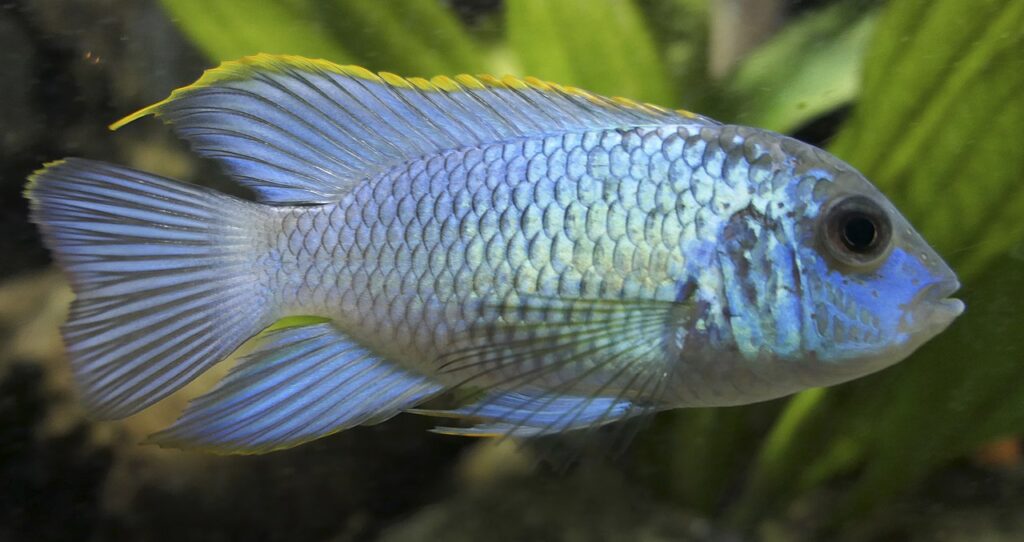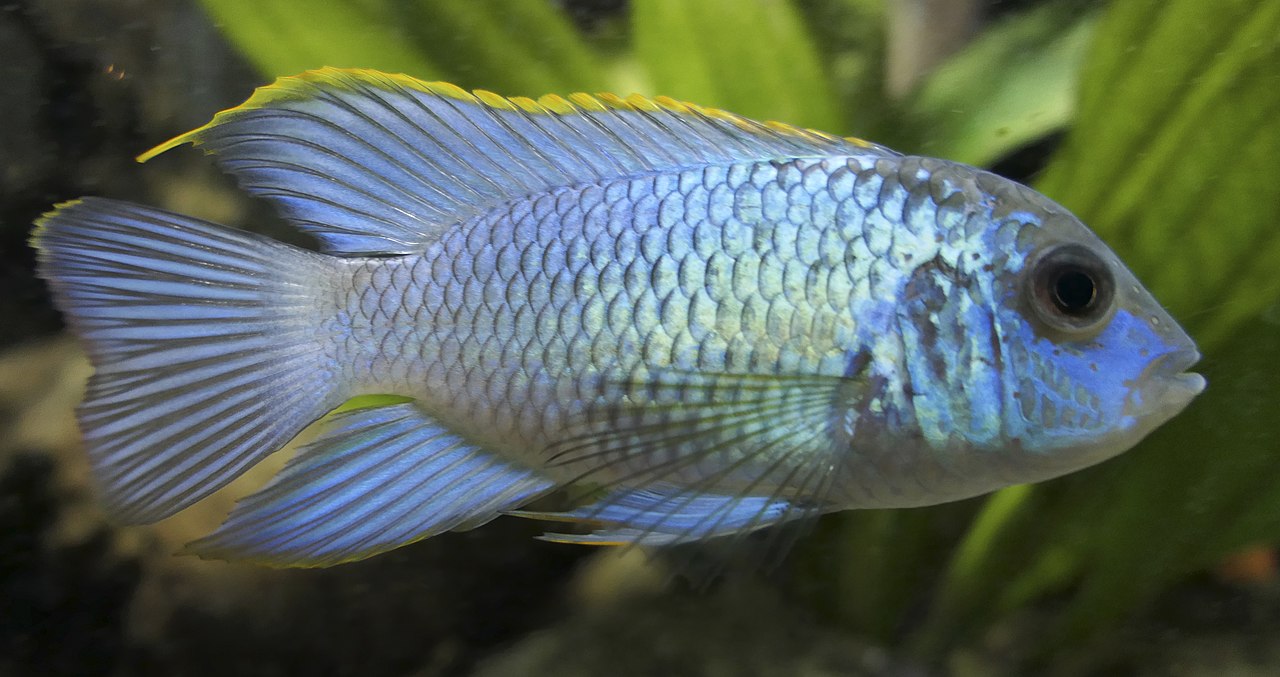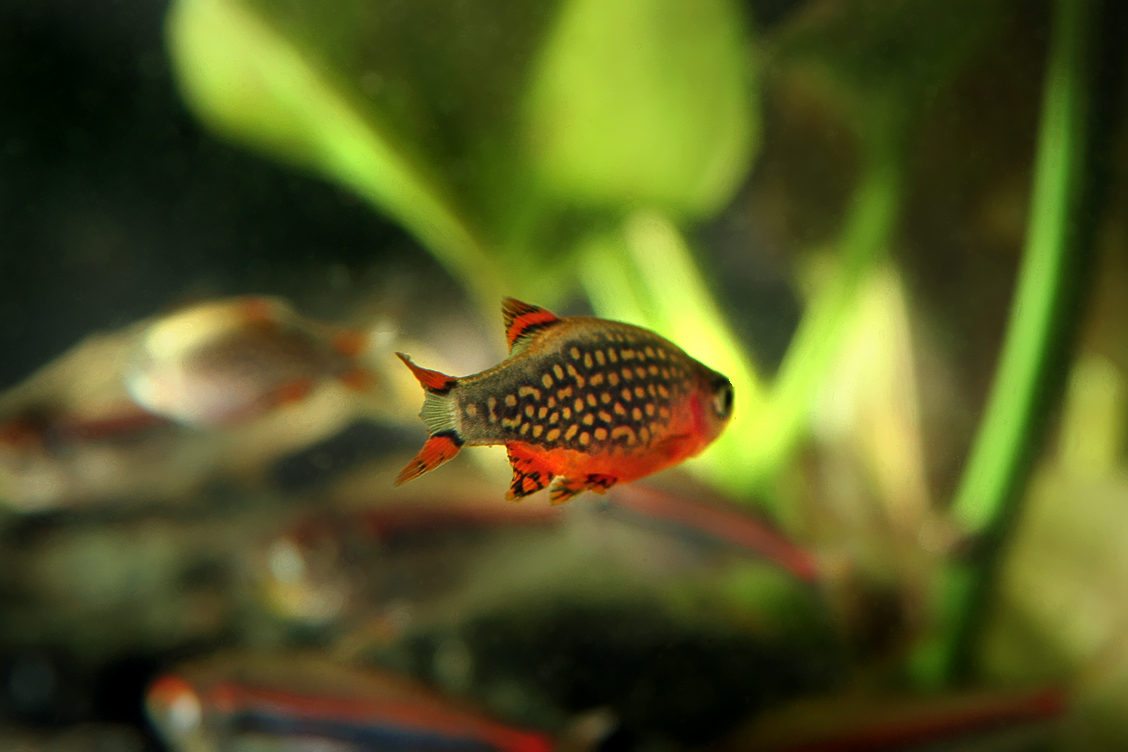Electric Blue Acara, scientifically known as Andinoacara pulcher, is a beautiful freshwater fish from the Cichlidae family. This bright blue fish is not only eye-catching but also amicable, making it a great addition to various community tanks.
Table of Contents
The Electric Blue Acara’s scientific classification includes the species name A. pulcher and it belongs to the Cichlidae family. Its colors range from electric blue to teal and metallic green, and it has some relations to other cichlid species.
While not considered rare, the Electric Blue Acara is prized for its vibrant hues. It’s a selectively bred variant of the more common Blue Acara. Among the variants, the electric blue coloration is the most popular, appreciated for its aesthetic appeal.
Native to parts of Trinidad and Tobago, Venezuela, and the Amazon Basin, this fish prefers dwelling in the middle of the tank. Its diet is varied, including small insects, crustaceans, and plant matter. Generally peaceful, it exhibits calm behavior and a friendly temperament, making it a joy to watch.
Statistics reveal that the Electric Blue Acara grows to around 6-7 inches in length and can live for 8-10 years. A tank of at least 30 gallons is recommended for these stunning fish.
Facts about the Electric Blue Acara include its origin from selective breeding and its suitability for community tanks due to its non-aggressive nature. Keeping them in proper water conditions will ensure they retain their striking colors.
There are also some fun facts associated with this fish. It’s known to play with its food, exhibiting intelligence, and its exotic appearance doesn’t translate to complicated care, making it accessible to beginners.
The history of the Electric Blue Acara is quite fascinating. Although the original Blue Acara has been known for over a century, the electric blue variant is relatively new. Its beauty and ease of care have quickly made it a favorite in aquariums around the world.
In summary, the Electric Blue Acara offers both beauty and a calming presence in an aquarium. Whether you’re an expert or a novice, this fish’s striking appearance and gentle nature are sure to add a touch of elegance and tranquility to your tank.

Key Information
The Electric Blue Acara is a captivating freshwater fish, known for its brilliant hues. Among the different variants of the Blue Acara, the electric blue variant stands out for its exceptional beauty. This particular variant has been selectively bred to achieve the vibrant blue color that makes it a favorite among aquarium enthusiasts. Now, let’s delve into some detailed information about this remarkable fish.
| Family | Cichlidae |
| Price | Typically $15-$25 depending on size and quality |
| Common Names | Electric Blue Acara |
| Variants | Electric blue variant of the Blue Acara |
| Ideal Tank Size | Minimum 30 gallons |
| Water Parameters | pH 6.5-7.5, Temperature 75-80°F (24-27°C) |
| Lifespan | 8-10 years |
| Full Size | 6-7 inches |
| Natural Environment | Trinidad and Tobago, Venezuela, Amazon Basin |
| Behavior | Generally peaceful, non-aggressive |
| Habitat Preference | Mid-dweller |
| Aquarium Decoration | Rocks, plants, driftwood |
| Ideal Tank Mates | Non-aggressive fish like tetras, catfish |
| Fish to Avoid | Aggressive species, large predatory fish |
| Best Foods/Diet | Small insects, crustaceans, plant matter |
| Disease | Susceptible to common fish diseases if stressed |
| Sex-Switch | No known sex-switching behavior |
| Gender Differences | Males are slightly larger, more colorful |
| Care Level | Moderate |
| Breeding Level | Moderate; they can breed in captivity with care |
Ideal Tank Mates
The Electric Blue Acara is known for its peaceful temperament, making it an excellent candidate for community tanks. Being generally non-aggressive, it can coexist harmoniously with various tank mates. Below are detailed descriptions of some ideal tank mates that would complement the Electric Blue Acara’s nature. Whether you’re aiming for an aesthetically pleasing arrangement or prioritizing compatibility, these options offer diversity and balance.
Tetras
Tetras are schooling fish that add color and movement to an aquarium. Their peaceful nature and small size make them great companions for the Electric Blue Acara.
Corydoras Catfish
These bottom-dwellers are calm and gentle, making them suitable for sharing a tank with the mid-dwelling Electric Blue Acara.
Dwarf Gouramis
Known for their beautiful appearance and peaceful demeanor, Dwarf Gouramis can coexist well with the Electric Blue Acara without clashing for territory.
Angelfish
Although somewhat territorial, when given enough space, Angelfish can make stunning and compatible tank mates for Electric Blue Acaras.
Platies
Platies are easy-going and come in various colors. Their non-aggressive nature makes them excellent tank mates for the Electric Blue Acara.
Swordtails
Much like Platies, Swordtails are peaceful fish that can share a tank without conflict.
Mollies
Mollies are compatible due to their friendly nature, and their variety in color adds a nice visual appeal to the tank.
Rasboras
These small schooling fish are perfect for a community tank with Electric Blue Acaras, as they prefer similar water parameters.
Guppies
Guppies are one of the most popular freshwater aquarium fish, and their vibrant colors and easy-going nature make them suitable companions.
Cherry Barbs
These fish are peaceful and prefer to be in groups, offering a nice contrast to the Electric Blue Acara’s striking color.
Otocinclus Catfish
Otocinclus are great algae eaters and can peacefully share the tank with Electric Blue Acaras.
Kuhli Loaches
These intriguing bottom-dwellers can add an interesting dynamic to the tank and are compatible in temperament.
Zebra Danios
Zebra Danios are active swimmers and their energy adds a lively touch to the aquarium.
Discus
Though slightly more challenging to care for, Discus can be a compatible and stunning addition to a well-maintained tank with Electric Blue Acaras.
Rainbowfish
Their iridescent colors and peaceful nature make Rainbowfish an attractive and compatible choice.
Ghost Shrimp
A non-fish option, Ghost Shrimp can coexist well with Electric Blue Acaras, adding diversity to the tank.
Together, these species offer a range of sizes, colors, and behaviors that can create a vibrant and harmonious community aquarium. Selecting ideal tank mates for the Electric Blue Acara can enhance not only the visual appeal of the aquarium but also the overall well-being and enrichment of the fish.
FAQs
How Do Electric Blue Acaras Interact with Plants in the Aquarium?
Electric Blue Acaras are generally not harmful to live plants in the aquarium. They may dig around the base of the plants, but they typically do not cause significant damage. It is advisable to secure plants properly to prevent any accidental uprooting.
Can Electric Blue Acaras be Kept with Invertebrates?
Yes, Electric Blue Acaras can generally be kept with invertebrates like shrimp and snails. They are not known to prey on these creatures, making them suitable tank mates.
What Types of Substrate are Best for Electric Blue Acaras?
Soft, sandy substrates are ideal for Electric Blue Acaras, as they like to dig and sift through the substrate. Coarse or sharp substrates should be avoided as they can cause damage to the fish.
Is Special Lighting Required for Electric Blue Acaras?
While Electric Blue Acaras don’t require special lighting, a well-lit tank can accentuate their beautiful coloration. Avoiding overly bright or harsh lighting can make the environment more comfortable for them.
How Do You Differentiate Between a Healthy and an Unhealthy Electric Blue Acara?
A healthy Electric Blue Acara will display vibrant colors, clear eyes, and an active demeanor. Signs of distress or illness may include dull colors, lethargy, clamped fins, or visible spots and wounds.
Can Electric Blue Acaras Change Color?
Yes, Electric Blue Acaras can experience color changes based on factors like diet, water quality, stress, and breeding condition. Proper care and attention to their environment can ensure that they maintain their vibrant hues.
What Kind of Filtration System is Ideal for Electric Blue Acaras?
A gentle filtration system that doesn’t create strong currents is recommended. The system should provide efficient biological and mechanical filtration without causing turbulence that might stress the fish.
What are the Signs that Electric Blue Acaras are Ready to Breed?
When ready to breed, Electric Blue Acaras may display increased color intensity, engage in pairing behaviors, and may be seen cleaning flat surfaces for egg-laying. Observing these signs can help aquarists prepare for successful breeding.
Can Electric Blue Acaras be Kept in a Species-only Tank?
Yes, Electric Blue Acaras can thrive in a species-only tank. They are social and do well in groups, and a species-only setup allows their vibrant colors and unique behaviors to be the focal point of the aquarium.
Are Electric Blue Acaras Sensitive to Water Parameter Changes?
While Electric Blue Acaras can tolerate a range of water conditions, sudden changes in water parameters can cause stress. It’s essential to maintain stability in the tank environment and make gradual adjustments if necessary.
How Should Electric Blue Acaras be Acclimated to a New Tank?
Acclimation should be done slowly, ideally using the drip method over the course of an hour or more. This slow adjustment helps them adapt to the new water parameters without causing undue stress.
Is it Normal for Electric Blue Acaras to Dig in the Substrate?
Yes, Electric Blue Acaras are known to dig in the substrate. This natural behavior allows them to forage for food, and it’s a common part of their daily activities in the aquarium.
What is the Recommended Group Size for Electric Blue Acaras?
While they can be kept individually, Electric Blue Acaras typically enjoy being in small groups. A group of 5 or more can promote more natural behaviors and create a more dynamic tank environment.
Can Electric Blue Acaras Jump Out of the Tank?
Though not common, Electric Blue Acaras may jump if stressed or frightened. It’s advisable to have a securely fitted lid on the tank to prevent any accidental escapes.
How to Encourage the Best Coloration in Electric Blue Acaras?
Providing a varied diet rich in nutrients, maintaining clean water, and ensuring proper lighting can help encourage the Electric Blue Acaras to display their best coloration. Keeping them stress-free also plays a vital role in their appearance.







